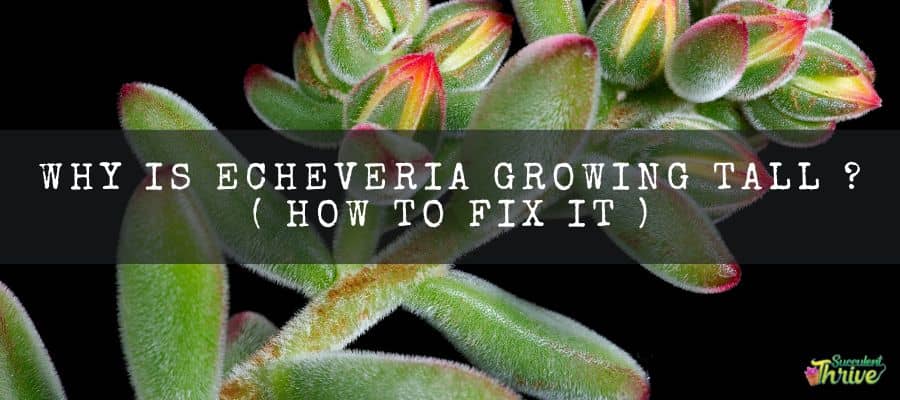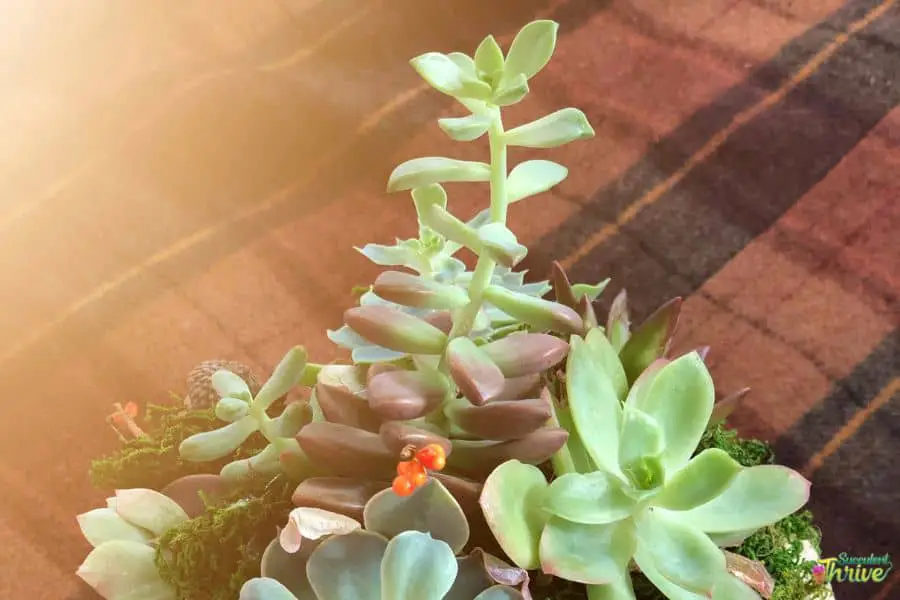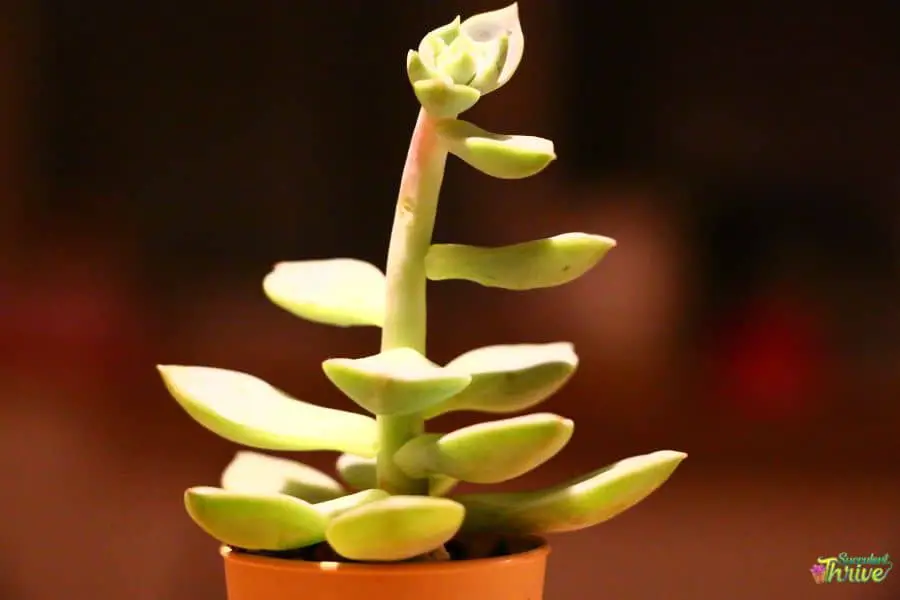Once I had a beautiful echeveria plant. But after a few months, it became unbelievably tall for such a small plant. When they grow tall, they lose their beauty to some extent. That happens to my plants too. So I wanted to know “why is echeveria growing tall?” and ways to overcome this problem. In this article I am trying to share my experiences regarding this matter.
If echeveria don’t get enough sunlight, they will grow tall. When you grow them inside, you can usually see this happening. Echeverias are fast growing succulents, and you might be surprised to see how fast they grow. However, this condition is known as etiolation scientifically.

Why Is Echeveria Growing Tall?
Usually, the echeverias get as tall as 12 inches when they are fully mature. However, whenever your echeverias are growing leggy and stretched , the simplest thing you can do is to expose them to more sunlight. So, if I briefly explain, echeverias tend to stretch in the best possible direction so they can absorb more sunlight. You could first witness how the echeverias turn and bend towards the light source, which they can approach. Once this happens, they will develop more space between the leaves.
Here, the leaves would be tiny when compared to their regular size. Furthermore, they would be lighter in color as well, and they would not be as attractive as they used to be once they suffered from this condition. Although this is more common among indoor-grown Echeverias, it can also be found among outdoor-grown Echeverias on occasion. For example, if you have cultivated the plants outdoors in a shady spot, you could see the Echeverias going through this condition quite a lot.
Early signs of Echeveria growing tall
If you spot drooping or flattened out leaves, it literally means an early sign of echeverias growing taller. After that, you could see the Echeveria leaves tend to curl backward and develop. Having said that, over exposure to sunlight may also curl up the succulent leaves. More space between the leaves, on the other hand, indicates that the echeverias are not receiving enough sunlight. One of the first indications that you might see is this.
Your echeverias will have a flawless appearance if they are receiving enough sunlight. However, they can also grow in low light conditions, though they wouldn’t look as good. One might assume that they are not developing properly as well. However, there’s a chance that the echeverias will die if they are unable to receive enough sunlight for longer than two years.

How to save stretched out echeveria
If you wish to save the spread of our Echeverias, the best thing to do is propagation. First, you need to cut off the succulent top. You could use sharp scissors to do this task. However, ensure that they are sterile and then make use of them. When you make the cutting, you should leave at least one or two inches at the base. Furthermore, make sure that it has at least two or three leaves.
Do not leave the plant base bare, as it would take a longer time to produce new shoots. If you had left one or two leaves on the stem, they would have developed new shoots somewhat faster. If the cuttings are longer than you expected, you could trim that off so that it would be shorter.
Now you can leave the cuttings and the base to wither for a couple of days. The intention of doing this activity is to allow them to develop callousness. You can see their cut edges are all dried up and tend to take on the look of scabbed once they are callused. Next, you can plant the cuttings in an appropriate soil mix and care for them.
Keep in mind that you need to water the cuttings more than what you do for the regular plants. However, don’t over water them as it would be unhealthy for the plants. If you don’t use a well-draining soil mix, the stems will become mushy and rot will occur.
They would start to develop roots in a short period. In fact, you could spot them sprouting within two to three weeks. Once they develop firm roots, you can minimize watering the plants. On the other hand, within a few weeks, the plants’ roots would produce new offshoots. The leaves you left on the base plants are likely to fall, but this is a common occurrence that you can ignore.
Secondly, you need to expose the plants to more sunlight, as if you keep growing them under low light levels, your new plants as well as the new shoots will again develop lengthy growth in the plants. So, before you propagate the plants or trim off the lengthy growth, you need to first locate the plants in a spot where they can gain sufficient sunlight. If you cannot move the plants , consider making use of grow lights to supplement the light levels.
Usually, echeverias need bright indirect sunlight. One might find it difficult to fulfill this requirement when they grow them indoors in winter. So, in that circumstance, what you could do is to locate grow lights closer to the plants and place them closer to a bright sunny window edge. So, I hope now you are well aware of what to do if your Echeveria tends to lean toward a certain direction or develops lengthy growth.
Can you cut the top off an echeveria?
Yes, certainly you can cut the top off an echeveria. However, I recommend doing this in times where the daytime would be dry and the nighttime would be cooler. This literally means you could do this in spring. Avoid doing this in the fall and in mid-winter. Before going ahead with this activity, you need to ensure whether the new growth cells are green. If the cells in the new growth are brown and woody, it literally means the plants don’t have sufficient growth cells.
When you do this activity, ensure that you cut it straight across the stem. When you do this, you need to make sure that you are using tools such as knives or clippers that are sharp enough. After that, cut the trunk just a few inches below the rosette. This tip is intended to reveal the cells that are actively growing.
You must also examine the specimen for any diseases in the meantime. Additionally, the top portion of the stem or the bottom edge of the rosette would both be firm. It literally means the tissues are healthy. On the other hand, if those cutting edges are darkened, it literally means the cuttings are weak or diseased. After that you could go ahead with the replanting process.

Related questions
How do you prune Echeveria?
When pruning the echeverias, first you need to get proper cutting tools. I recommend using bonsai scissors as they would be perfectly suitable for this purpose. They are sharp and light in weight. So, anybody can use them effectively. However, ensure that you clean them well before using them unless you are exposing the plants to diseases. If there are hard to reach dead leaves on the plants, you may use long-handled tweezers to do the task. Next, arrange a towel as you need to wipe off the dirt from your hands.
Pruning the echeverias is very simple. However, you should identify the amount of the plant you need to prune as it would vary based on the plant’s height. Bear in mind to leave several healthy leaves on the plants, as only then can they conduct the photosynthesis process. Only then they can collect energy and develop new shoots.
If your Echeveria has formed a corky wooden stem, you could use pruners to get rid of the corked part of the plant. Alternatively, you may also use razor blades to do this task. Ensure that you prune the plant parts slightly above the set of leaves so that it will look neat. Furthermore, it would make the plants less attractive to diseases. Keep providing the right care for the plants and locate them in a spot where they can gain bright indirect sunlight. Do not discard the cuttings as you can make use of them for propagation and to make new plants.
Why is my succulent growing a long stem in the middle?
Succulents will grow long stems in the middle when they lack sufficient sunlight. You could call this process etiolation. They would lean towards the best possible direction where they could absorb sunlight and it would result in this condition.
How do you shorten succulents?
You can first get a sharp pair of scissors and cut off the desired amount of the succulent. However, when you shorten the succulents, ensure that you are keeping one or two leaves on the base plants. Additionally, ensure that it has enough stem parts.
What do you do with lanky succulents?
First and foremost, you could get rid of the unhealthy leaves from the plants. That would help the plants to come up with healthy growths and get rid of the lanky look of the plants. Next , you may consider repotting the plants as well. If your plants tend to develop a lanky look, it literally means the plants are running out of ample sunlight.
So, you need to expose the pants to increased lighting levels. If you have grown succulents in a garden, you need to think of a way to increase the lighting levels for the plants. If you have cultivated them indoors, you could simply shift them to a bright, sunny windowsill. Furthermore, you may consider bringing the plants outdoors during the summer to solve this condition.
Do succulents grow bigger in bigger pots?
Succulents don’t grow big when you cultivate them in bigger pots. Instead, it would tend to retain more water within the pots, which would turn out to be unhealthy for the plants. It would not encourage the healthy growth of the plants either. Having said that succulents can survive in bigger pots, Once you grow the succulents in bigger pots, there wouldn’t be much room for the roots to spread and the plants would struggle to fill the container with the roots.
Conclusion
To recap, echeverias may grow taller if they run out of ample sunlight. So, if you ever come across any occurrence like this, I hope now you are well aware of how to handle it. Echeverias are a lovely and versatile group of plants that will thrive if given the proper growing conditions.
Read Next : How To Grow A Jade Plant Into A Tree? ( Secret To A Thicker Trunk )
